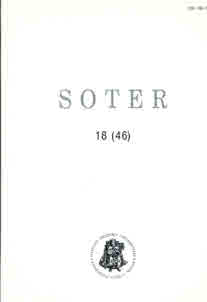Liturginės orientacijos judaizme ir krikščionybėje lyginamoji analizė
Comparative study of liturgical orientation in Judaism and Christianity
Author(s): Benas UlevičiusSubject(s): Christian Theology and Religion
Published by: Vytauto Didžiojo Universitetas
Keywords: liturgija; liturginė orientacija; judaizmas; krikščionybė; ikonografija; šventasis menas; krikščionybės simboliai; Eucharistija; liturgy; liturgical orientation; Judaism; Christianity; iconography; sacred art; Christian symbols; Eucharist;
Summary/Abstract: The main object of this article is the phenomena of religious orientation in two biblical religions – Judaism and Christianity. Judaism’s orientation towards the Temple of Jerusalem and Christian orientation towards the cosmic east are discussed separately, and then compared, with historical circumstances provided. Finally, the conclusions are drawn from the comparison of their theologies and ways in which they were applied in liturgy and prayer in both mentioned religions. Temple of Jerusalem was held in Judaism the true axis mundi, the place where presence of Yahweh abided in greatest possible fullness on earth. Jerusalem itself was a city of David, i.e. the Messianic city, the main locus of fulfillment of God’s promises to his people and the object of messianic hope of Israel. Because of such significance Jerusalem with its Temple after Babylonian exile became absolute object of sacred orientation of Judaism. Orientation towards the Holy City was expressed essentially in two ways: by orienting synagogues towards Jerusalem and by turning to Jerusalem in prayer. It seems that Christianity from the very beginning of its existence chose the cardinal direction of east as an object of its sacred orientation. Such choice was build first of all upon biblical and theological significance of the east. East was held by the early Church the symbol of Christ’s Resurrection and Parousia. According to the Bible east was a place of Paradise and divine presence. Great significance attached to the “Eastern gates of the Temple” in the book of Ezekiel, played its part as well in recognition of Christological symbolism of the east. Christian orientation towards the rising sun was embodied in many details of liturgical worship and ecclesiological practices. Most evident expression of the symbolic significance of the east was a practice of building the churches according the east–west axis, and celebration of the Eucharist towards the rising sun. Of all theological meanings of Christian symbolism of oriens, east as the place of heavenly Jerusalem with eternal Temple in which perfect sacrifice of Christ is offered is of greatest importance when we try to explain Christian orientation in relation with Judaic orientation towards the mundane Jerusalem. Displacement of objects of orientation at the time Christianity acquired the understanding of its uniqueness and identity did not mean just a rejection of Judaism which historically was the cradle of the Church, but as well a continuation. Turning towards the east as the place of heavenly Jerusalem in its own way confirmed the significance of the mundane Jerusalem: the New Jerusalem was a fulfillment of all meanings of the mundane Holy City and continued its function in new, transcended way. The mundane Jerusalem lost its significance only because its invisible model became possible to contemplate in the symbol of the divine east.
Journal: SOTER: religijos mokslo žurnalas
- Issue Year: 48/2006
- Issue No: 20
- Page Range: 53-74
- Page Count: 22
- Language: Lithuanian

